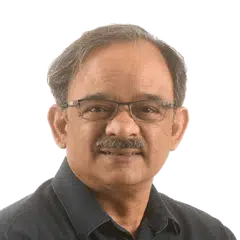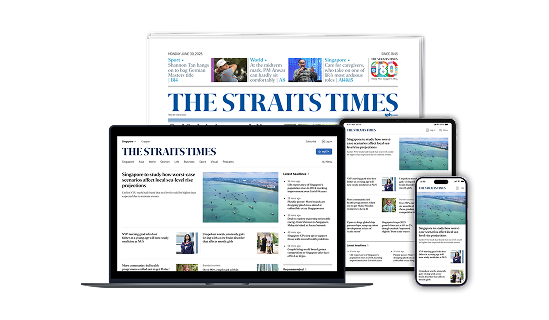Singapore’s new task force to address immediate tariff shock, and also plan for the future
Sign up now: Get ST's newsletters delivered to your inbox

(From left) SNEF president Tan Hee Teck, Manpower Minister Tan See Leng, NTUC secretary-general Ng Chee Meng, DPM Gan Kim Yong, SBF vice-chairman Mark Lee, National Development Minister Desmond Lee, Digital Development and Information Minister Josephine Teo and Transport Minister Chee Hong Tat at a press conference on April 16.
ST PHOTO: NG SOR LUAN
Follow topic:
SINGAPORE - Businesses and workers in Singapore will get help to cope with the immediate impact of the recent US tariffs and, in time, new measures will be rolled out to ensure Singapore continues to thrive even as global trade is reshaped, and supply chains are reconfigured.
Speaking at the first press conference of the Singapore Economic Resilience Taskforce on April 16, Deputy Prime Minister Gan Kim Yong said the US’ new tariff regime, its escalating trade war with China, and the threat of new levies on semiconductors and pharmaceuticals have caused significant uncertainty and downside risks to the global economy and Singapore.
Singapore, which currently imposes zero tariffs on US imports, is still subject to the baseline 10 per cent rate. While much higher tariffs announced for other countries have been put on hold for a 90-day period,
“Given potential downside risks, we cannot rule out the possibility of a recession this year,” DPM Gan said.
“Some companies in Singapore are already affected – for example, those who have manufacturing operations in China, or sell to manufacturers in China, are already seeing cancelled or deferred orders.”
DPM Gan, who is also the Minister for Trade and Industry, was appointed to chair the task force by Prime Minister Lawrence Wong on April 8
DPM Gan said an economic slowdown will also impact jobs and wages, hence the task force will help Singapore companies, especially small and medium-sized enterprises, tackle their immediate challenges.
However, in the longer term, the disorderly imposition of tariffs and retaliatory measures will fundamentally undermine the rules-based multilateral system and reshape the global trading order.
“This will adversely affect small economies like Singapore which depend on trade to develop and grow our economy,” DPM Gan said.
He said the task force will look into how existing schemes can help companies survive the immediate shock and retain their workforce. Later on, when there is more clarity on how the global economy is changing in response to heightened protectionism, Singapore will launch new schemes as and when necessary.
The task force includes four other Cabinet ministers, along with representatives of Singapore’s economic and tripartite agencies.
They are Minister for National Development Desmond Lee, Minister for Digital Development and Information Josephine Teo, Minister for Manpower Tan See Leng and Minister for Transport Chee Hong Tat.
Rounding out the team are the Singapore Business Federation’s (SBF) chairman Lim Ming Yan, the Singapore National Employers Federation’s president Tan Hee Teck and the National Trades Union Congress’ secretary-general Ng Chee Meng.
Specifically, the task force will focus on three key areas: communications and “sensemaking” for businesses and workers, addressing their immediate challenges, and longer-term strategies for Singapore.
“We will have to continue to manage the crisis and as the situation evolves, we will have to respond with new measures in a timely manner,” said DPM Gan.
Analysts say the global trade disruption caused by Mr Trump’s off-and-on tariff policy is likely to cost Singapore’s export-driven economy far more than the relatively lower 10 per cent tariff on its exports to the United States.
The Ministry of Trade and Industry on April 14 downgraded its forecast for full-year 2025 gross domestic product (GDP) growth
On the same day, the Monetary Authority of Singapore reduced the pace of the local currency’s trade-weighted appreciation
A cheaper currency may help Singapore exports by offsetting some of the price impact from the new tariff.
DPM Gan said the Budget statement announced in February already has several initiatives that will help business and households.
Analysts estimate that the initiatives in the $143 billion Budget
Singapore is currently a key financial and trans-shipment hub and critical supplier of semiconductors, pharmaceuticals, petrochemicals and transport engineering goods, such as aircraft engines and offshore rigs and platforms.
It is deemed the most susceptible among Asean economies to a tariff-induced global slowdown, given that more than 60 per cent of its nominal GDP comes from value-added local production that is ultimately consumed overseas.
A recent SBF survey found 71 per cent of local businesses have an offshore presence,
DPM Gan said that while it is important to tackle the short-term impact of the tariffs, there needs to be a long-term view on how Singapore can reposition itself in the global economy.
“At the same time, we should also bear in mind that even in these choppy waters, and amid this turmoil, there will be opportunities. As our supply chains get reconfigured, there will be pockets of opportunities that we will be able to tap.
“We need to help our companies to be nimble, to continue to invest in upgrading and innovation, developing new markets, developing new products and services, and at the same time, continue to invest in our people so that they can have the skills necessary to deal with new markets and products,” he said.


